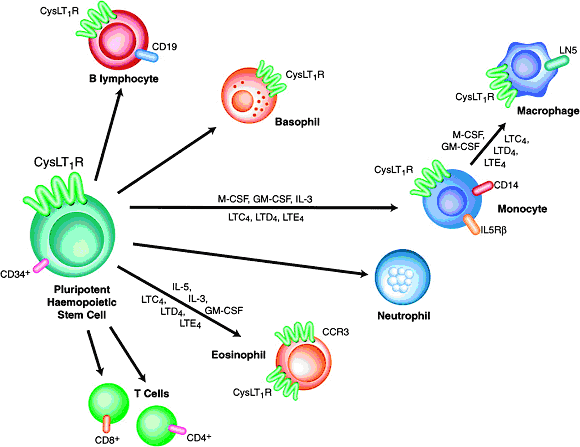 |
||||||||||
Date: November 15, 2025
by Chaya Venkat
Related Articles:

Civilization is a very recent phenomenon in the history of Man, and in some important ways it has turned our very bodies against us. Even just a couple of generations ago, the main cause of death was infections of various sorts. Millions of years of evolution and genetic selection has seen to it that we have very alert and powerful immune systems, a trigger happy immune defense mechanism was a matter of survival. But modern babies raised on the tenets of "Childcare by Dr. Spock" see very few pathogens in their sterilized and ultra clean surroundings. Have you heard the phrase "idle hands are the devil's workshop"? Our immune systems have much less to do than they were designed for, and in the process of making work for themselves, they sometimes go more than a little crazy, with serious consequences.
We are all familiar with the signs of inflammation, the redness, pain and heat generated at the site of a cut, or an insect bite. Under normal circumstances, this is a good thing. When the ever vigilant cells of the immune system find an enemy, they rush to attack and release powerful chemical signals attracting more troops to that location. But too much of a good thing can be bad for you — sometimes the chemical alarm goes off even when there is no enemy to fight and does not switch itself off after a decent interval. This is chronic inflammation, and today it is recognized to be the cause of many diseases. The short list of diseases that can be aided and abetted by chronic inflammation include cancer, autoimmune diseases like lupus, MS, rheumatoid arthritis, Crohn's disease, autoimmune diabetes, cardiovascular disease and Alzheimer's disease, just to name a few. I think you get the picture, chronic inflammation is no small problem and it is certainly an issue for CLL patients. We have discussed several aspects of inflammation as it pertains to CLL, such as Cox-1 and Cox-2 in other articles. This article focuses on one specific aspect of chronic inflammation that seems to have been recently discovered and very intriguing connections to CLL.
Compounds called cysteinyl leukotrienes (CysLTs) are important mediators of inflammation. Once synthesized, leukotrienes exert very powerful pro-inflammatory effects such as those seen asthma, wheezing, bronchial spasms, mucus formation, sinusitis, etc. We will focus on just one of the leukotrienes, called LTD4. Before moving on to CLL, let us see what happens in an asthmatic episode. LTD4 is formed as part of the inflammatory process and it is found liberally in the lungs and associated airways. Cells that have the right receptor (called CysLT1) that mates with LTD4 are attracted to the site. Among these are various immune system cells such as monocytes, eosinophils and macrophages. Drawn by the siren call of LTD4, these immune system cells congregate in great numbers in the lungs. Mating of the LTD4 with the right receptors on the immune system cells causes production of more LTD4, which then attracts even more immune system cells and so on. This creates a snowball effect, quickly getting out of control. Cutting through a great deal of very complex biochemistry, here is the bullet-point version of how all this impacts CLL patients.
 |
If you have been a patient reader and waded through all this strange stuff, here is your reward, some practical things that you could discuss with your doctor. A number of very specific and low-toxicity drugs have been approved by the FDA for use in controlling asthma. These drugs work by blocking the receptors for LTD4. Two well known ones are "Singulair" ('montelukast' - Merck & Co.), and "Accolate" ('zafirlukast' - Zeneca Pharmaceuticals). A third one "Ultair" ('pranlukast' - SmithKline Beecham) has been approved in Europe and Japan, and is in late stage trials in this country.
1601] The Leukotriene Receptor CysLT1 Is Involved in Migration and Survival of Chronic Lymphocytic Leukemia (CLL) Cells: Potential Role of CysLT1Antagonists in the treatment of CLL
Andreas M. Boehmler, Gabriele Seitz, Tina Wiesner, Lothar Kanz, Robert Mhle Department of Medicine II, University of Tbingen, Tbingen, Germany
G protein-coupled receptors (GPR) mediate chemotactic and proliferative effects in both normal and malignant hematopoietic cells. CysLT1, a GPR for a subgroup of lipid mediators (cysteinyl-leukotrienes), is involved in inflammatory reactions such as allergic asthma, but its ligands are also released in the bone marrow by stromal and endothelial cells similar to the chemokine SDF-1. In RT-PCR analyses, we now demonstrate expression of CysLT1 in the CLL cell lines EHEB and MEC-1, as well as in CD19+ cells isolated immunomagnetically from the peripheral blood of patients with B-CLL. Stimulation of CLL cells with the natural CysLT1 ligand cysteinyl leukotriene D4 (LTD4) resulted in a sustained effect on the cytoskeleton with a 37.8% increase in the concentration of filamentous actin. In transmigration experiments throughfenestrated polycarbonate membranes (pore size: 5 M), CLL cells responded positively chemotactic to LTD4, with an increase in the total number of transmigrated cells of up to 6-fold as compared to carrier alone. In addition, the CysLT1 receptor antagonist MK-571 drastically decreased the in vitro survival of primary CLL cells as well as of CLL cell lines. Interestingly, antiproliferative effects were seen at receptor antagonist concentrations (low micromolar), which could potentially be achieved by oral treatment in vivo. We conclude that expression of CysLT1 may contribute to bone marrow tropism of CLL cells and their maintenance in the hematopoietic microenvironment. More important, the highly antiproliferative effect of CysLT1 receptor antagonists, which are currently used only in asthma therapy, might offer a new approach in the therapy of CLL.
Abstract #1601, ASH 2025
____________________
Curr Opin Otolaryngol Head Neck Surg. 2025 Jun;11(3):184-91.
The role of leukotriene inhibitors in patients with paranasal sinus disease.
Parnes SM.
Department of Surgery, Division of Otolaryngology, Albany Medical College, Albany, New York
Leukotrienes are inflammatory mediators that are known as the slow-reacting substance of anaphylaxis produced by a number of cell types including mast cells, eosinophils, basophils, macrophages, and monocytes. Synthesis of these mediators results from the cleavage of arachidonic acid in cell membranes, and they exert their biologic effects by binding and activating specific adaptors. This occurs in a series of events that lead to contraction of the human airway smooth muscle, chemotaxis, and increased vascular permeability. These effects have led to their important role in the diseases of asthma, allergic rhinitis, and possible paranasal sinusitis with the formation of nasal polyps. Because these agents lead to the production of symptoms in patients that are asthmatic, the use of leukotriene enzyme inhibitors, particularly montelukast, and zafirlukasts seem appropriate. These classes of drugs can block the binding of leukotrienes to CysLT(1) receptors. Zileuton is a 5-lipoxygenase inhibitor that prevents the formation of leukotrienes and can also result in the prevention of leukotriene activity. Demonstrated efficacy in these patients in a number of studies has also suggested their role in inhibiting nasal symptoms in asthmatic patients. In addition, it has been suggested by serendipitous observations that many of the aspirin-intolerant patients have nasal polyps and that treatment with the leukotriene inhibitors has resulted in improvement and resolution of the polyps. Therefore, these agents may also play a role in patients afflicted with chronic sinusitis with concomitant nasal polyposis. These papers are discussed in detail because this form of therapy may represent a novel way to treat patients with this malady in addition to or in lieu of surgical treatment and steroid therapy.
PMID: 12923360
_____________
Gastroenterology. 2025 Jan;124(1):57-70.
Expression of the leukotriene D4 receptor CysLT1, COX-2, and other cell survival factors in colorectal adenocarcinomas.
Ohd JF, Nielsen CK, Campbell J, Landberg G, Lofberg H, Sjolander A.
Division of Experimental Pathology, Department of Laboratory Medicine, Malmo University Hospital, Lund University, SE-205 02 Malmo, Sweden.
BACKGROUND & AIMS: The effects of leukotriene (LT) D(4) on intestinal epithelial cells govern events that are involved in cell survival and colon cancer, notably increased expression of cyclooxygenase (COX)-2 and enhanced production of prostaglandin E(2). We investigated possible correlations between distribution of the recently described LTD(4) receptor CysLT(1)R and factors previously shown to be up-regulated by LTD(4) as well as clinicopathologic traits.
METHODS: Immunohistochemistry and in situ hybridization were performed on tissue arrays, which were made using colorectal cancer samples from 84 patients.
RESULTS: CysLT(1)R was significantly correlated to COX-2, 5-lipoxygenase, and Bcl-x(L). Male subjects more often exhibited high levels of this receptor relative to female subjects, and Dukes' B patients with elevated CysLT(1)R expression showed markedly poorer survival than those with low-level expression. Furthermore, this was paralleled by an increased viability of CysLT(1)R-overexpressing cells in a colon cancer cell line.
CONCLUSIONS: Our results further implicate the involvement of LTs in colorectal carcinoma. Based on our present and earlier findings, we propose that LT/CysLT(1)R signaling facilitates survival of colon cancer cells, which may affect disease outcome. Like COX-2, LTs are accessible targets for pharmacologic treatment.
PMID: 12512030
_____________
Am. J. Respir. Crit. Care Med., Volume 163, Number 1, January 2025, 226-233
Expression of the Cysteinyl Leukotriene 1 Receptor in Normal Human Lung and Peripheral Blood Leukocytes
Figueroa DJ, Breyer RM, Defoe SK, Kargman S, Daugherty BL, Waldburger K, Liu Q, Clements M, Zeng Z, O'Neill GP, Jones TR, Lynch KR, Austin CP, Evans JF.
Department of Nephrology, Vanderbilt University, Nashville, Tennessee; Department of Pharmacology, University of Virginia Health Sciences Center, Charlottesville, Virginia; Department of Pharmacology, Merck Research Laboratories, West Point, Pennsylvania; Department of Biochemistry and Molecular Biology, Merck Frosst Canada Inc., Dorval, Quebec, Canada; and Department of Immunology, Merck Research Laboratories, Rahway, New Jersey
The cysteinyl leukotrienes (CysLTs) are important mediators of human asthma. Pharmacologic and clinical studies show that the CysLTs exert most of their bronchoconstrictive and proinflammatory effects through activation of a putative, 7-transmembrane domain, G-protein-coupled receptor, the CysLT1 receptor. The initial molecular characterization of the CysLT1 receptor showed by in situ hybridization, the presence of CysLT1 receptor messenger RNA (mRNA) in human lung smooth-muscle cells and lung macrophages. We confirmed the results of these in situ hybridization analyses for the CysLT1 receptor, and produced the first immunohistochemical characterization of the CysLT1 receptor protein in human lung. The identification of the CysLT1 receptor in the lung is consistent with the antibronchoconstrictive and antiinflammatory actions of CysLT1 receptor antagonists. We also report the expression of CysLT1 receptor mRNA and protein in most peripheral blood eosinophils and pregranulocytic CD34+ cells, and in subsets of monocytes and B lymphocytes.
Link: Article in American Journal of Respiratory and Critical Care Medicine.
PMID: 11208650
_____________
 Enter Keywords: |
———
Disclaimer: The content of this website is intended for information only and is NOT meant to be medical advice. Please be sure to consult and follow the advice of your doctors on all medical matters.
Copyright Notice:
Copyright © 2025-2007 CLL Topics, Inc. All Rights Reserved.
All materials contained on this site are protected by United States copyright law and may not be reproduced, distributed, transmitted, displayed, published or broadcast without the prior written permission of CLL Topics, Inc. You may not alter or remove any trademark, copyright or other notice from copies of the content.
However, you may download and print material from CLLTopics.org exclusively for your personal, noncommercial use.
———
